While customer experience is and will continue to be a key differentiator for all companies, data and AI is at the heart of meeting the elevated expectations of today’s connected customers, writes Vala Afshar, chief digital evangelist at Salesforce
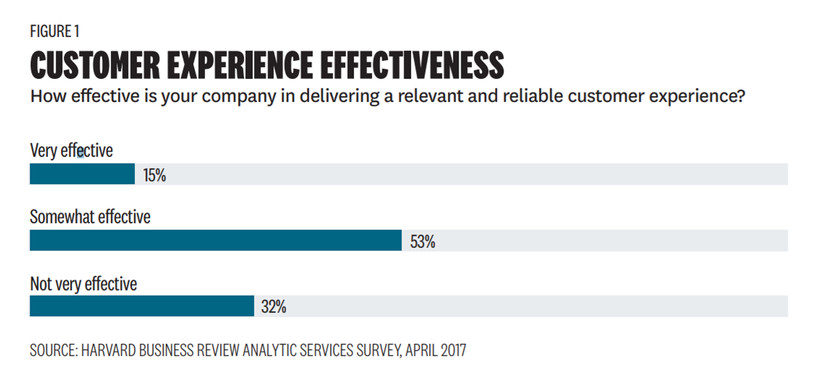
HBR Analytics Services | Customer Experience Effectiveness
Research from Harvard Business Review Analytics Services, sponsored by Salesforce, found that a mere 15% of business leaders rated their customer service strategy and approach as very effective.
These are among the findings of a new Harvard Business Review Analytic Services study of 680 executives about customer experience management—research that features in-depth interviews with several top-performing company leaders.
The report also identified barriers that prevent companies from gaining a single view of the customer. Here are the key research findings:
The key to customer experience transformation
The top three success factors for customer experience transformation are: customer centric culture, management/leadership buy-in, and visibility into and understanding of the end customer experience.

HBR Analytics Services | The Most Important Factors To Delivering An Effective Customer Experience
“Business leaders are clear about the most important factors in delivering superior customer experiences today. Topping the list is creating a customer centric culture, cited by nine out of 10 respondents.”
- Three-quarters of companies are not able to act on the majority of data they collect, owing in large part to disjointed systems and data integration issues
- Only 13% of companies have a single source of customer intelligence today, and 30% are working toward that
- Only 23% of business leaders are able to act on all or most of the customer data that they collect
“Data and systems integration and visibility across the enterprise, giving employees the power to deliver and innovate around customer experience, and aligning IT decision-making with customer experience demands were all cited as extremely important in delivering a superior customer experience. Yet only around a quarter of respondents said their companies perform well in these areas.”
What sets customer experience leaders apart
The research reveals that customer experience (CX) leaders are more likely to be using emerging technologies and creating personalized and omnichannel experiences. CX leaders are also more likely to use data to predict and anticipate consumer needs, understand lifetime value, and track customer advocacy. CX leaders also have a much higher sense of urgency - they believe there is no time to waste in transforming to deliver a superior customer experience.
- 73% of business leaders say that delivering a relevant and reliable customer experience is critical to their company’s overall business performance
- 93% of business leaders agree that a relevant and reliable customer experience is critical to their company’s overall performance in two years
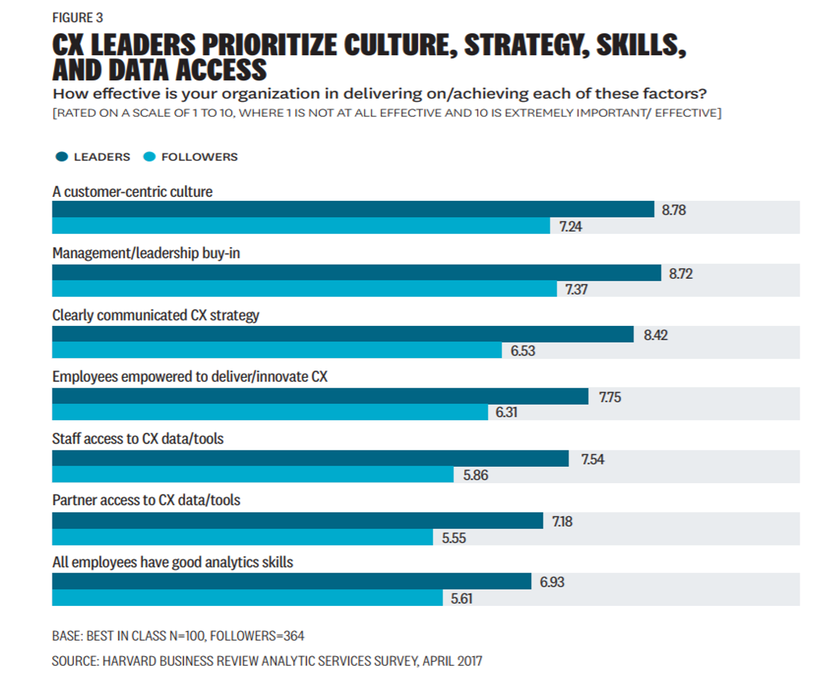
HBR Analytics Services | CX Leaders Prioritize Culture, Strategy, Skills, and Data Access
“The 15% of respondents who described their customer experience as very effective— reveals some fundamental differences between these forward-leaning organizations and others. They are more likely to have a customer-centric culture and a single source of customer intelligence. They are more capable and agile in leveraging their customer data to drive customer experience efforts, giving their employees and partners access to the tools and insights needed to create a superior customer experience.”
The need for speed and agility
According the research, forward-looking companies have invested in new technologies capable of consolidating and analyzing key customer data and have reorganized to be able to act on that customer insight in a more nimble way.
- 86% of customer experience leaders believe their companies are able to quickly build new and innovative customer experiences in response to market dynamics
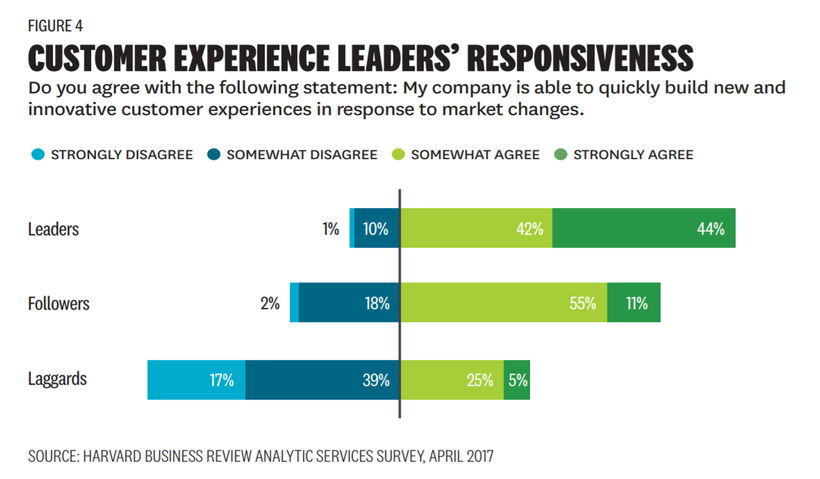
“Social media, mobile, and e-commerce or website data have seen the highest levels of growth. The expansion of third-party, partner, and beacon data has been more modest, although customer experience leaders report substantially higher rates of growth in these three areas, as well as in machine or sensor and e-commerce data.”
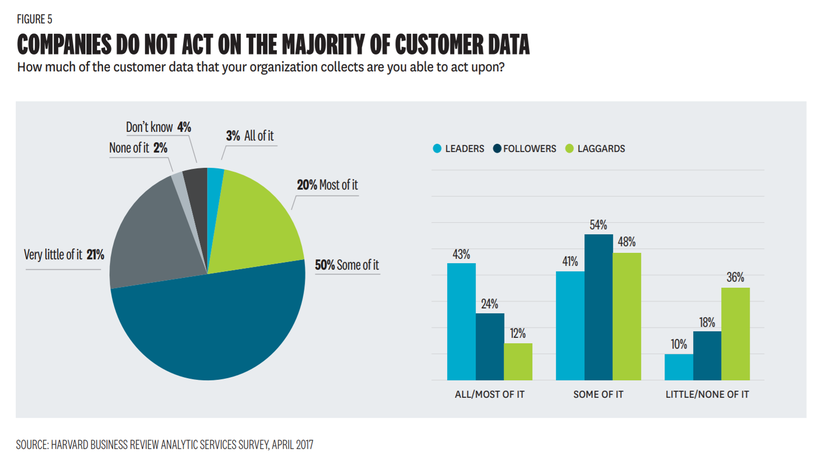
HBR Analytics Services | Companies Do Not Act on the Majority of Customer Data
“Data has a clear role to play in developing a superior customer experience— and companies have access to more information on their customers than ever before. Indeed, they are seeing an exponential increase in customer-related data, driven largely by social media, mobile, and e-commerce. But these expanding troves of customer information alone are clearly not driving customer experience improvements—let alone innovation—in the vast majority of organizations.” — Harvard Business Review Analytic Services
- Only 23% of companies act on most or all of the customer data they collect, while a similar number (23%) said they act on very little or none of it, and the remainder use some of it.
- 40% of CX leaders said confidently that they are able to quickly act on the data they do use to make enhancements to the customer experience, compared to just 11% of followers and 5% of laggards.
A single source of truth remains elusive
The growth of data volume and sources means that most companies struggle to create a single source of customer intelligence. Just 13% have it today, and 30% are actively working on it.
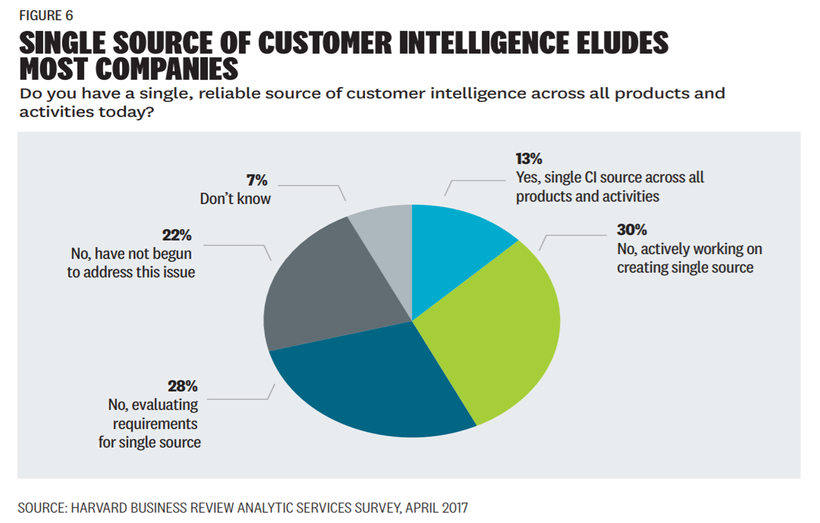
HBR Analytics Services | Single Source of Customer Intelligence Eludes Most Companies
The top three barriers for creating a single source of customer intelligence are: 1. operational silos, 2. lack of systems or data standardization or integration, and 3. data quality issues.
In my experience as a chief customer office and chief marketing officer, the biggest barrier is leadership’s understanding of the importance of clean, usable data. In the age of artificial intelligence, where algorithms are developed to augment and accelerate organizational efficiency and effectiveness, the quality of data is of critical importance.
Business leaders must articulate the importance of data quality, and collaborate with IT and other lines-of-business in order to develop an insight driven culture with share visibility and opportunities for co-creation of value.
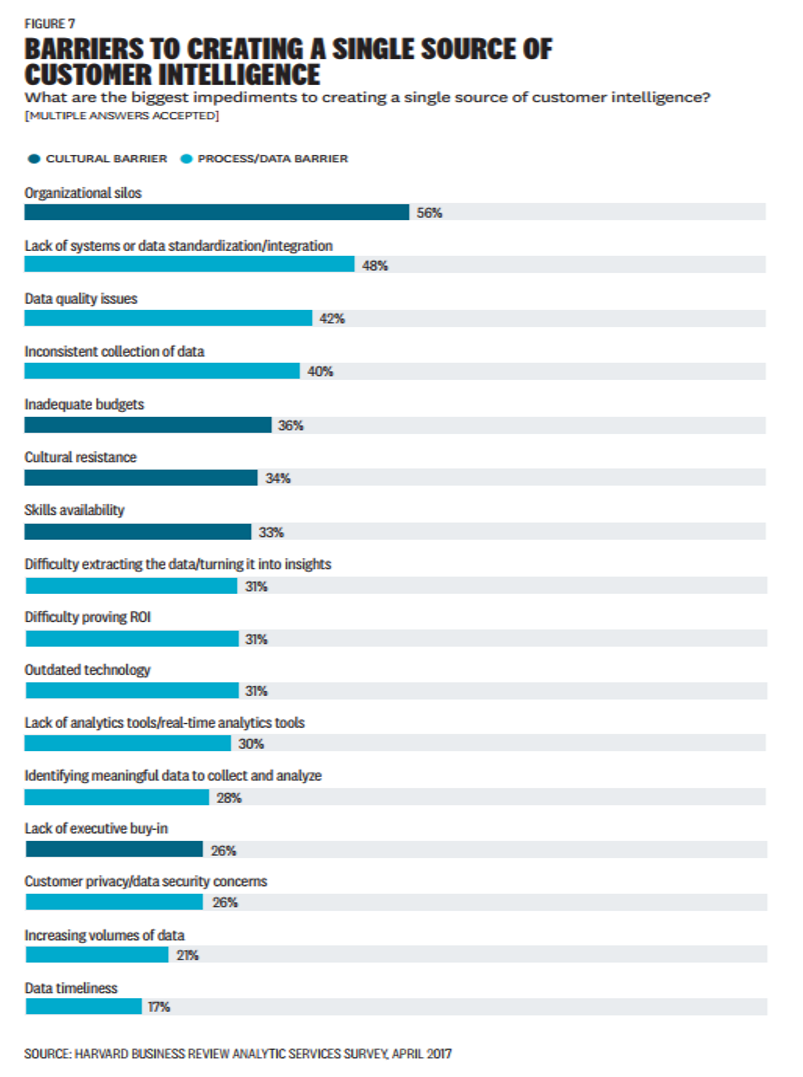
HBR Analytics Services | Barriers to Creating a Single Source of Customer Intelligence
Creating a platform for customer experience innovation
The most important sources of customer experience data are: 1. customer relationship management systems (75%), 2. customer satisfaction surveys (53%), 3. social media tools (43%), 4. feedback from sales and retail staff (40%), 5. email or SMS (37%), and 6. transaction data (34%).
The sources of data that are actually used for customer experience are: 1. CRM (54%), 2. customer satisfaction surveys (52%), 3. websites (50%), 4. contact center managers 4. (41%), and feedback from sales and retail staff (31%).
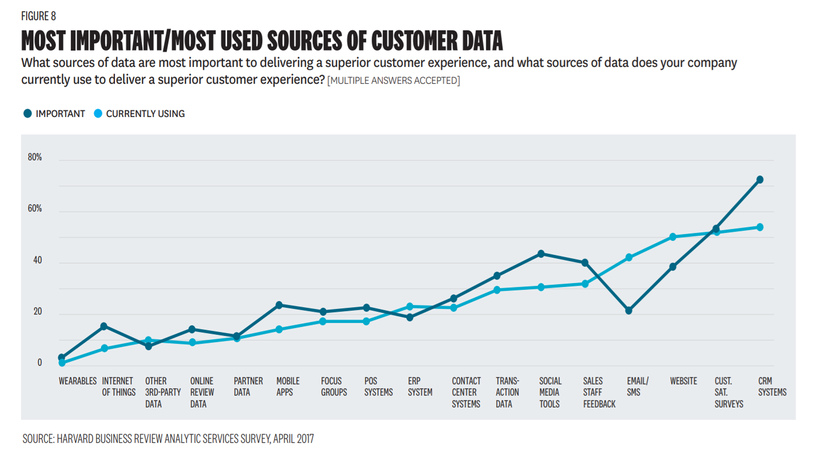
HBR Analytics Services | Most Important/Most Used Sources of Customer Data - CRM is #1
“The institutional investment and benefits provider threw out its proprietary CRM platform, replacing it with a software-as-a-service option that, in conjunction with a marketing automation system, serves as the company’s technology hub of customer insight.” — HBR Analytics Services
Increasing the return on customer data
- 40% of businesses have used or will use customer data to customize or personalize experiences for individuals
- 37% of businesses use customer data to predict or anticipate customer needs
- 20% of businesses are using customer data to create an omni-channel experience.
“Companies are most likely to leverage customer data to deliver improved customer insight to employees, engage customers in new or innovative ways, streamline customer-facing processes, and improve customer responsiveness— all important data-driven improvements.”
The top three use cases for leveraging customer data to improve the customer experience are: 1. improve customer insights for employees, 2. new and innovative customer engagement and 3. streamlining customer-facing processes.
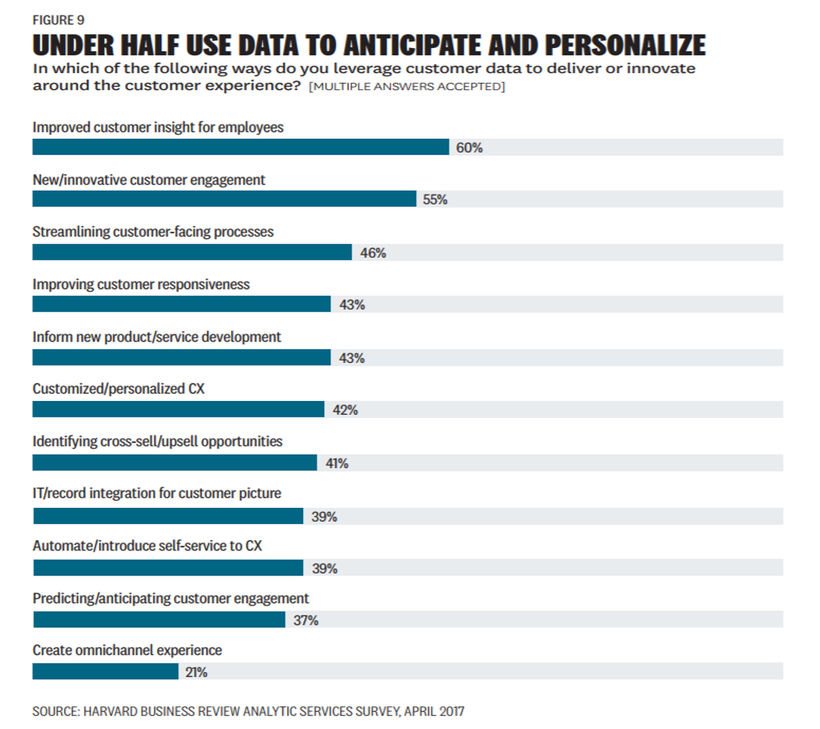
HBR Analytics Services | Under Half Use Data To Anticipate And Personalize
“For those with the right technology architecture in place, providing customer intelligence to employees and partners can be a more straightforward exercise than it is for those still struggling with disparate customer data and systems.”
The future of CX: Advanced analytics and artificial intelligence
According to the research, the biggest and most significant shift will be the use of advanced predictive analytics to drive data-driven customer experience decisions.
“A significant strategic shift is coming in terms of the tools companies use to deliver superior customer experience. Website and email channels, which are more dominant today, will become much less business-critical. Meanwhile, mobile apps, chatbots, and other AI-driven tools will grow in importance.”
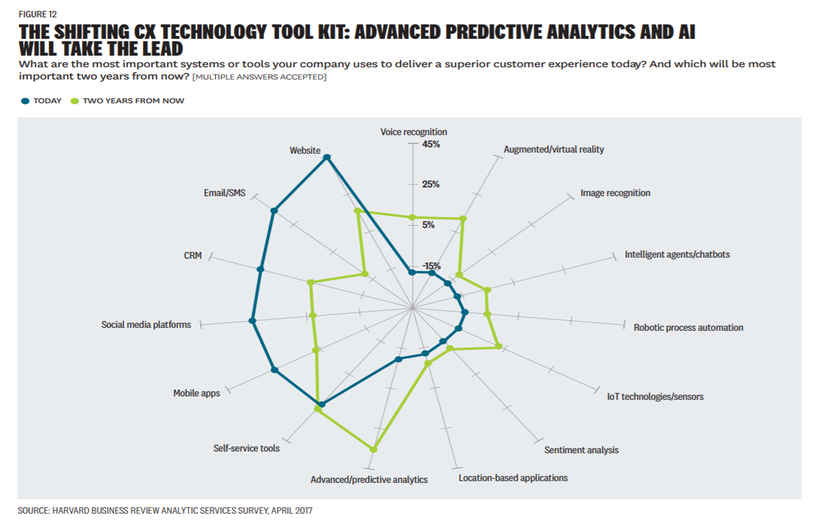
HBR Analytics Services | The Shifting CX Technology Tool Kit: AI Will Take The Lead
New ways to measure customer success
Companies today are more likely to measure customer experience effectiveness with customer satisfaction surveys (56%) than any other method, followed by customer retention or repeat sales (42%).
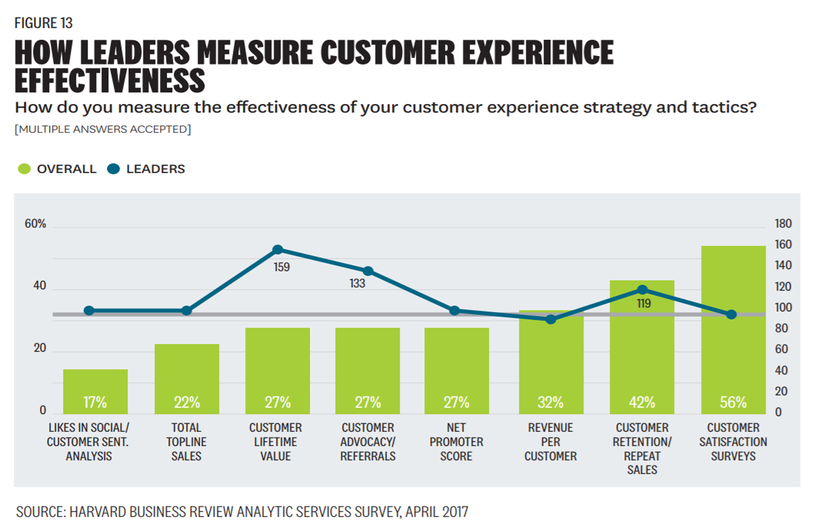
HBR Analytics Services | How CX Leaders Measure Customer Experience Effectiveness
The customer experience payoff
Customer experience efforts are only a priority insofar as they benefit the bottom line. And it’s becoming clear that they do. Customer experience is and will continue to be a key differentiator for all companies.
The research concluded with a call to action, advising customer experience leaders to:
- Have unambiguous executive support for customer experience transformation
- Develop a clear customer experience transformation strategy built on desired customer experience outcomes
- Create a customer-centric culture throughout the enterprise • Break down customer data and organizational silos
- Align IT priorities with customer experience demands
- Invest in next-generation customer technology that can deliver a single source of customer insight across functions
- Partner with vendors and consultants with experience and skills required to collect, analyze, and act on expanding volumes of customer data
- Empower employees to deliver and innovate around customer experience
Data is at the heart of meeting the elevated expectations of today’s connected customers. When applied wisely, the flood of customer data from countless devices and systems of record allows companies to know precisely when, why, and how to engage at the individual level.
The competitive battleground is now squarely based on superior customer experience. Companies that are data-driven will compete, grow and win. Companies that place a lower emphasis on data quality, data analysis and faster shared customer insights used to improve the customer experience, will disappear in the very near future.
Vala Afshar is the Chief Digital Evangelist at Salesforce.
This article was orginally posted at The Huffington Post and is reproduced with permission from the author.
Save
Save
Save































